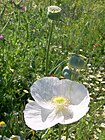Note: This is a project under development. The articles on this wiki are just being initiated and broadly incomplete. You can Help creating new pages.
Difference between revisions of "Papaver somniferum - Khakhasa"
(→List of Ayurvedic medicine in which the herb is used) |
|||
| (2 intermediate revisions by the same user not shown) | |||
| Line 1: | Line 1: | ||
[[File:Papaver somniferum - bourgeon.jpg|thumb|right]] | [[File:Papaver somniferum - bourgeon.jpg|thumb|right]] | ||
| − | '''Khakhasa''' consists of seed of Papaver somniferum Linn. | + | '''Khakhasa''' consists of seed of Papaver somniferum Linn. It is a glaucous erect annual herb cultivated under State control in certain areas of Rajasthan, Madhya Pradesh and Uttar Pradesh. |
| − | |||
==Uses== | ==Uses== | ||
{{Uses|Dysentery}}, {{Uses|Cough}}, {{Uses|Constipation}}, {{Uses|Fever}}, {{Uses|Insomnia}}. | {{Uses|Dysentery}}, {{Uses|Cough}}, {{Uses|Constipation}}, {{Uses|Fever}}, {{Uses|Insomnia}}. | ||
| Line 12: | Line 11: | ||
==Common names== | ==Common names== | ||
| − | {{Common names|kn=Gasgase, Aapheen | + | {{Common names|kn=Gasgase, Aapheen|ml=Avin, Karappu|sa=Khasatilaḥ, Āphūkam, Khākhastilaḥ, Khākhasaḥ|ta=Kasakash, Posttakkaai|te=Gasgashaalu, Nallamandu|hi=Apheem, Postadaanaa|en=Opium, Poppy Seeds}} |
==Properties== | ==Properties== | ||
| Line 37: | Line 36: | ||
===Flower=== | ===Flower=== | ||
| − | {{Flower|Unisexual|2-4cm long| | + | {{Flower|Unisexual|2-4cm long|Pink||Flowering throughout the year and In terminal and/or axillary pseudoracemes}} |
===Fruit=== | ===Fruit=== | ||
| − | {{Fruit| | + | {{Fruit|Oblong pod|Thinly septate, pilose, wrinkled|||Seeds upto 5|Fruiting throughout the year}} |
===Other features=== | ===Other features=== | ||
| Line 77: | Line 76: | ||
<references> | <references> | ||
<ref name="chemical composition">The Ayuredic Pharmacopoeia of India Part-1, Volume-5, Page no-12</ref> | <ref name="chemical composition">The Ayuredic Pharmacopoeia of India Part-1, Volume-5, Page no-12</ref> | ||
| − | <ref name="Leaf">[ | + | <ref name="Leaf">[Morphology]</ref> |
| − | <ref name="How to plant/cultivate">[http://tropical.theferns.info/viewtropical.php?id=Papaver+somniferum | + | <ref name="How to plant/cultivate">[http://tropical.theferns.info/viewtropical.php?id=Papaver+somniferum Cultivation detail]</ref> |
</references> | </references> | ||
==External Links== | ==External Links== | ||
*[https://en.wikipedia.org/wiki/Papaver_somniferum Papaver somniferum on en.wikipedia.org] | *[https://en.wikipedia.org/wiki/Papaver_somniferum Papaver somniferum on en.wikipedia.org] | ||
| − | *[https://www.ncbi.nlm.nih.gov/pubmed/6905769 Papaver somniferum on ncbi. | + | *[https://www.ncbi.nlm.nih.gov/pubmed/6905769 Papaver somniferum on ncbi.gov] |
*[https://www.opioids.com/red.html Papaver somniferum on Opioids.com] | *[https://www.opioids.com/red.html Papaver somniferum on Opioids.com] | ||
[[Category:Herbs]] | [[Category:Herbs]] | ||
[[Category:Papaveraceae]] | [[Category:Papaveraceae]] | ||
Latest revision as of 17:28, 26 June 2020
Khakhasa consists of seed of Papaver somniferum Linn. It is a glaucous erect annual herb cultivated under State control in certain areas of Rajasthan, Madhya Pradesh and Uttar Pradesh.
Contents
- 1 Uses
- 2 Parts Used
- 3 Chemical Composition
- 4 Common names
- 5 Properties
- 6 Habit
- 7 Identification
- 8 List of Ayurvedic medicine in which the herb is used
- 9 Where to get the saplings
- 10 Mode of Propagation
- 11 How to plant/cultivate
- 12 Commonly seen growing in areas
- 13 Photo Gallery
- 14 References
- 15 External Links
Uses
Dysentery, Cough, Constipation, Fever, Insomnia.
Parts Used
Chemical Composition
Fixed oil containing esters of linoleic, palmitic, oleic acids.[1]
Common names
| Language | Common name |
|---|---|
| Kannada | Gasgase, Aapheen |
| Hindi | Apheem, Postadaanaa |
| Malayalam | Avin, Karappu |
| Tamil | Kasakash, Posttakkaai |
| Telugu | Gasgashaalu, Nallamandu |
| Marathi | NA |
| Gujarathi | NA |
| Punjabi | NA |
| Kashmiri | NA |
| Sanskrit | Khasatilaḥ, Āphūkam, Khākhastilaḥ, Khākhasaḥ |
| English | Opium, Poppy Seeds |
Properties
Reference: Dravya - Substance, Rasa - Taste, Guna - Qualities, Veerya - Potency, Vipaka - Post-digesion effect, Karma - Pharmacological activity, Prabhava - Therepeutics.
Dravya
Rasa
Madhura
Guna
Guru
Veerya
Śīta
Vipaka
Madhura
Karma
Vātahara, Rucya, Stambhana, Vedanāsthāpana, Vṛṣya, Balya, Varṇya
Prabhava
Habit
Identification
Leaf
| Kind | Shape | Feature |
|---|---|---|
| Paripinnate | Oblong | Leaf Arrangementis Alternate-spiral |
Flower
| Type | Size | Color and composition | Stamen | More information |
|---|---|---|---|---|
| Unisexual | 2-4cm long | Pink | Flowering throughout the year and In terminal and/or axillary pseudoracemes |
Fruit
| Type | Size | Mass | Appearance | Seeds | More information |
|---|---|---|---|---|---|
| Oblong pod | Thinly septate, pilose, wrinkled | Seeds upto 5 | Fruiting throughout the year |
Other features
List of Ayurvedic medicine in which the herb is used
Where to get the saplings
Mode of Propagation
How to plant/cultivate
A plant mainly of the subtropics, though it can be cultivated in the temperate zone and tropics[3].
Commonly seen growing in areas
Western Ghats, Open areas, Rocky areas.
Photo Gallery
References
- ↑ The Ayuredic Pharmacopoeia of India Part-1, Volume-5, Page no-12
- ↑ [Morphology]
- ↑ Cultivation detail
External Links
- Ayurvedic Herbs known to be helpful to treat Dysentery
- Ayurvedic Herbs known to be helpful to treat Cough
- Ayurvedic Herbs known to be helpful to treat Constipation
- Ayurvedic Herbs known to be helpful to treat Fever
- Ayurvedic Herbs known to be helpful to treat Insomnia
- Herbs with Flowers used in medicine
- Herbs with Fruits used in medicine
- Herbs with common name in Kannada
- Herbs with common name in Hindi
- Herbs with common name in Malayalam
- Herbs with common name in Tamil
- Herbs with common name in Telugu
- Herbs with common name in Sanskrit
- Herbs with common name in English
- Habit - Herb
- Index of Plants which can be propagated by Seeds
- Herbs that are commonly seen in the region of Western Ghats
- Herbs that are commonly seen in the region of Open areas
- Herbs that are commonly seen in the region of Rocky areas
- Herbs
- Papaveraceae







